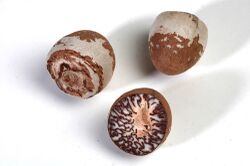Chemistry:Areca alkaloids

Areca alkaloids are a group of piperidine alkaloids found in the areca nut, the seeds of the areca palm (Areca catechu).[1]
Occurrence
Areca alkaloids are isolated from the areca nut, which are hemispherical seeds and are approximately 3 cm in size. Areca nuts are cultivated in India and East Asia.[1]
Representative
The main alkaloid is arecoline, which accounts for over 50% of the total alkaloid content.[2] Other representatives include arecaidine, guvacoline, and guvacine.[1]
The total alkaloid content of the nuts increases during ripening and decreases upon subsequent drying.[3] A roasting of dried nuts increases the proportion of arecoline in the total alkaloid content.[2][3]
Properties
Arecolin is a potent parasympathomimetic that enhances salivary and sweat secretion and stimulates intestinal activity. The vermifuge function of areca preparations is used today only in veterinary medicine.[1] Traditionally, areca nut has been used as an aphrodisiac, anorectic, digestive stimulant, and diuretic, as well as in the treatment of asthma, cough, dermatitis, fainting, glaucoma, erectile dysfunction, worm diseases, leprosy, toothache, and vaginal discharge, as well as to constrict the vagina.[4]
Areca nuts are typically chewed with lime and leaves of betel pepper, especially in East Asia (known as "sirih pinang"). This practice stimulates the nervous system in a manner akin to tobacco.[5][1]
References
- ↑ 1.0 1.1 1.2 1.3 1.4 Entry on Areca-Alkaloide. at: Römpp Online. Georg Thieme Verlag, retrieved {{{Datum}}}.
- ↑ 2.0 2.1 Vipin Jain, Apurva Garg, Mark Parascandola, Pankaj Chaturvedi, Samir S. Khariwala, Irina Stepanov (2017-02-28), "Analysis of Alkaloids in Areca Nut-Containing Products by Liquid Chromatography–Tandem Mass Spectrometry" (in en), Journal of Agricultural and Food Chemistry 65 (9): 1977, doi:10.1021/acs.jafc.6b05140
- ↑ 3.0 3.1 H. R. Shwetha, V. S. Kotrashetti, N. Reddy, N. Chaitanya Babu (2019-05-03), "Estimation of the Major Constituents of Arecanut in Its Different Forms" (in en), Austin Journal of Nutrition and Food Sciences 7 (1): 1113, http://smj.sma.org.sg/2704/2704smj11.pdf
- ↑ Ashish Bhalla, Ponniah Thirumalaikolundusubramanian, Jeffery Fung, Gabriela Cordero-Schmidt, Sari Soghoian, Veronica Kaur Sikka, Harinder Singh Dhindsa, Surjit Singh (2014), Meenakshisundaram Ramachandran, ed., "Chapter 6 - Native Medicines and Cardiovascular Toxicity" (in en), Heart and Toxins (Academic Press), doi:10.1016/B978-0-12-416595-3.00006-2, ISBN 978-0-12-416595-3
- ↑ Eberhard Breitmaier (1997), Alkaloide, Wiesbaden: Springer Fachmedien, pp. 37, ISBN 3-519-03542-1
 |






